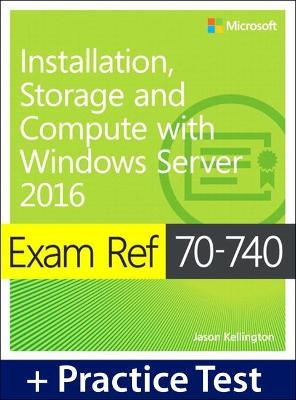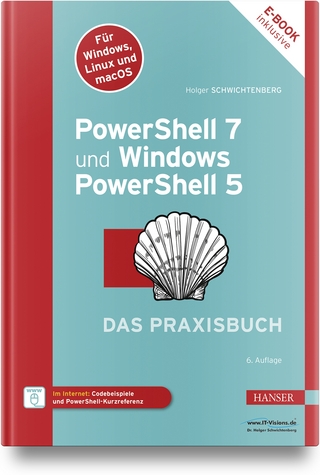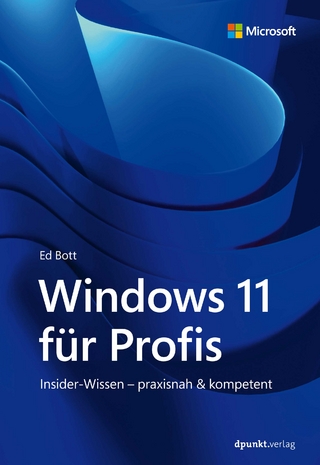
Exam Ref 70-740 Installation, Storage, and Compute with Windows Server 2016 with Practice Test
Microsoft Press (Verlag)
978-1-5093-0367-0 (ISBN)
- Keine Verlagsinformationen verfügbar
- Artikel merken
Focus on the expertise measured by these objectives:
Install Windows Servers in host and compute environments
Implement storage solutions
Implement Hyper-V
Implement Windows containers
Implement high availability
Maintain and monitor server environments
This Microsoft Exam Ref:
Organizes its coverage by exam objectives
Features strategic, what-if scenarios to challenge you
Assumes you have experience working with Windows Server in an enterprise environment; are familiar with core networking infrastructure, topologies, architectures, and protocols; and have experience with Windows clients and virtualization
About the Practice Test: This practice test contains 150 questions and robust explanations.
Candidates should be able to install Windows Server in host and compute environments, including Nano Server. Candidates should also be able to implement storage solutions and Windows Containers. Candidates should demonstrate proficiency in implementing Hyper-V and high availability and be able to monitor and manage servers.
Certification: This exam counts as credit toward the following certifications:
MCSE: SharePoint
This test contains 150 questions and covers the following objectives:
Install Windows Server in host and compute environments
Implement storage solutions
Implement Hyper-V
Implement Windows containers
Implement high availability
Maintain and monitor server environments
This test includes references to the following media:
Microsoft TechNet
MSDN
Microsoft.com
Microsoft Cloud Guides
Web resource
Office.com
ASP.NET
Web resource
Why Choose the Microsoft Official Practice Test powered by MeasureUp?Quality test content is extremely important to us so that you will be prepared on exam day. We ensure that all objectives of the exam are covered in depth so you'll be ready for any question on the exam. Our practice tests are written by industry experts in the subject matter. They work closely with certification providers to understand the exam objectives, participate in beta testing and take the exam themselves before creating new practice tests. Our quality content and innovative technology have earned the prestigious credential of Microsoft Certified Practice Test Provider.
Online performance-based simulations give hands on work environment experience
Questions are similar to exam questions so you test your knowledge of exam objectives
Detailed explanations for both correct and distractor answers reinforce the material
Study Mode covers all objectives ensuring topics are covered
Certification Mode (timed) prepares students for exam taking conditions
Instant, drill-down score reports tell you exactly the areas to focus on
How to obtain the Practice Test
The Official Microsoft Practice Test offered with this book is fulfilled by MeasureUp.com. With your order, you will receive a product key on your Account Page. Registering the product key at MeasureUp.com will give you access to a downloadable practice test which does not expire as well as 30-day access to the online version.
Before accessing your practice test, you will be required to create an account at MeasureUp.com if you don’t already have one.
The downloadable practice test is licensed by MeasureUp for a single user and can be downloaded on up to three different devices. Downloading practice tests to virtual machines is prohibited.
Craig Zacker is a writer, editor, and educator who has written or contributed to dozens of books on operating systems, networking, and PC hardware, as well as several college texts and online training courses. Craig is the author of the Windows Small Business Server 2008 Administrator's Pocket Consultant, and co-authored the MCITP Self-Paced Training Kit (Exam 70-686): Windows 7 Desktop Administrator.
Introduction
Preparing for the exam
Chapter 1 Install Windows Servers in host and compute environments
Skill 1.1: Install, upgrade, and migrate servers and workloads
Determine Windows Server 2016 installation requirements
Determine appropriate Windows Server 2016 editions per workloads
Install Windows Server 2016
Install Windows Server 2016 features and roles
Install and configure Windows Server Core
Manage Windows Server Core installations using Windows PowerShell, command line, and remote management capabilities
Implement Windows PowerShell Desired State Configuration (DSC) to install and maintain integrity of installed environments
Perform upgrades and migrations of servers and core workloads from Windows Server 2008 and Windows Server 2012 to Windows Server 2016
Determine the appropriate activation model for server installation
Skill 1.2: Install and configure Nano Server
Determine appropriate usage scenarios and requirements for Nano Server
Install Nano Server
Implement Roles and Features on Nano Server
Manage and configure Nano Server
Managing Nano Server remotely using PowerShell
Skill 1.3: Create, manage, and maintain images for deployment
Plan for Windows Server virtualization
Plan for Linux and FreeBSD deployments
Assess virtualization workloads using the Microsoft
Assessment and Planning (MAP) Toolkit
Determine considerations for deploying workloads into virtualized environments
Update images with patches, hotfixes, and drivers
Install Roles and Features in offline images
Manage and maintain Windows Server Core, Nano Server images, and VHDs using Windows PowerShell
Chapter 2 Implement storage solutions
Skill 2.1: Configure disks and volumes
Configure sector sizes appropriate for various workloads
Configure GUID partition table (GPT) disks
Create VHD and VHDX files using Server Manager or Windows PowerShell
Mount Virtual Hard Disks (VHDs)
Determine when to use NTFS and ReFS File Systems
Configure NFS and SMB shares using Server Manager
Configure SMB share and session settings using Windows PowerShell
Configure SMB server and SMB client configuration settings using Windows PowerShell
Configure file and folder permissions
Skill 2.2: Implement server storage
Configure storage pools
Implement simple, mirror, and parity storage layout options for disks or enclosures
Configure tiered storage
Configure iSCSI target and initiator
Configure iSNS
Configure Datacenter Bridging (DCB)
Configure Multipath I/O (MPIO)
Determine usage scenarios for Storage Replica
Implement Storage Replica for server-to-server, cluster-to-cluster, and stretch cluster scenarios
Skill 2.3: Implement data deduplication
Implement and configure deduplication
Determine appropriate usage scenarios for deduplication
Monitor deduplication
Implement a backup and restore solution with deduplication
Chapter 3 Implement Hyper-V
Skill 3.1: Install and configure Hyper-V
Determine hardware and compatibility requirements for installing Hyper-V
Install Hyper-V
Install management tools
Upgrade from existing versions of Hyper-V
Delegate virtual machine management
Perform remote management of Hyper-V hosts
Configure virtual machines using Windows PowerShell Direct
Implement nested virtualization
Skill 3.2: Configure virtual machine (VM) settings
Creating a virtual machine
Add or remove memory in running a VM
Configure dynamic memory
Configure Non-Uniform Memory Access (NUMA) support
Configure smart paging
Configure resource metering
Manage Integration Services
Create and configure Generation 1 and 2 VMs and determine appropriate usage scenarios
Implement enhanced session mode
Create Linux and FreeBSD VMs
Install and configure Linux Integration Services (LIS)
Install and configure FreeBSD Integration Services (BIS)
Implement Secure Boot for Windows and Linux environments
Move and convert VMs from previous versions of Hyper-V to Windows Server 2016 Hyper-V
Export and import VMs
Implement Discrete Device Assignment (DDA)
Skill 3.3: Configure Hyper-V storage
Create VHDs and VHDX files using Hyper-V Manager
Create shared VHDX files
Configure differencing disks
Modify virtual hard disks
Configure pass-through disks
Resize a virtual hard disk
Manage checkpoints
Implement production checkpoints
Implement a virtual fibre channel adapter
Configure Storage Quality of Service (QoS)
Skill 3.4: Configure Hyper-V networking
Add and remove virtual network interface cards (vNICs)
Configure Hyper-V virtual switches
Optimize network performance
Configure MAC addresses
Configure network isolation
Configure synthetic and legacy virtual network adapters
Configure NIC teaming in VMs
Configure virtual machine queue (VMQ)
Enable Remote Direct Memory Access (RDMA) on network adapters bound to a Hyper-V virtual switch using Switch Embedded Teaming (SET)
Configure bandwidth management
Chapter 4 Implement Windows containers
Skill 4.1: Deploy Windows containers
Determine installation requirements and appropriate scenarios for Windows containers
Install and configure Windows Server Container Host in physical or virtualized environments
Install and configure Windows Server container host to Windows Server Core or Nano Server in a physical or virtualized environment
Install Docker on Windows Server and Nano Server
Configure Docker Daemon start-up options
Configure Windows PowerShell for use with containers
Install a base operating system
Tag an image
Uninstall an operating system image
Create Windows Server containers
Create Hyper-V containers
Skill 4.2: Manage Windows containers
Manage Windows or Linux containers using the Docker daemon
Manage Windows or Linux containers using Windows PowerShell
Manage container networking
Manage container data volumes
Manage resource control
Create new container images using Dockerfile
Manage container images using DockerHub
Repository for public and private scenarios
Manage container images using Microsoft Azure
Chapter 5 Implement high availability
Skill 5.1: Implement high availability and disaster recovery options in Hyper-V
Implement Hyper-V Replica
Implement live migration
Implement shared nothing live migration
Configure CredSSP or Kerberos authentication protocol for Live Migration
Implement storage migration
Skill 5.2: Implement failover clustering
Implement workgroup, single, and multi domain clusters
Configure quorum
Configure cluster networking
Restore single node or cluster configuration
Configure cluster storage
Implement cluster-aware updating
Implement cluster operating system rolling upgrade
Configure and optimize clustered shared volumes (CSVs)
Configure clusters without network names
Implement Scale-Out File Server (SoFS)
Determine different scenarios for the use of SoFS vs. clustered file server
Determine usage scenarios for implementing guest clustering
Implement a clustered Storage Spaces solution using shared SAS storage enclosures
Implement Storage Replica
Implement cloud witness
Implement VM resiliency
Implement shared VHDX as a storage solution for guest clusters
Skill 5.3: Implement Storage Spaces Direct
Determine scenario requirements for implementing Storage Spaces Direct
Enable Storage Spaces direct using Windows PowerShell
Implement a disaggregated Storage Spaces Direct scenario in a cluster
Implement a hyper-converged Storage Spaces Direct scenario in a cluster
Skill 5.4: Manage failover clustering
Configure role-specific settings, including continuously available shares
Configure VM monitoring
Configure failover and preference settings
Implement stretch and site-aware failover clusters
Enable and configure node fairness
Skill 5.5: Manage VM movement in clustered nodes
Perform a live migration
Perform a quick migration
Perform a storage migration
Import, export, and copy VMs
Configure VM network health protection
Configure drain on shutdown
Skill 5.6: Implement Network Load Balancing (NLB)
Configure NLB prerequisites
Install NLB nodes
Configure affinity
Configure port rules
Configure cluster operation mode
Upgrade an NLB cluster
Chapter 6 Maintain and monitor server environments
Skill 6.1: Maintain server installations
Implement Windows Server Update Services (WSUS) solutions
Configure WSUS groups
Manage patch management in mixed environments
Implement an antimalware solution with Windows Defender
Integrate Windows Defender with WSUS and Windows Update
Perform backup and restore operations using Windows Server Backup
Determine backup strategies for different Windows Server roles and workloads, including Hyper-V Host, Hyper-V Guests, Active Directory, File Servers, and Web Servers using Windows Server 2016 native tools and solutions
Skill 6.2: Monitor server installations
Monitor workloads using Performance Monitor
Configure data collector sets
Determine appropriate CPU, memory, disk, and networking counters for storage and compute workloads
Configure alerts
Monitor workloads using Resource Monitor
| Erscheinungsdatum | 20.11.2017 |
|---|---|
| Verlagsort | Boston |
| Sprache | englisch |
| Maße | 187 x 229 mm |
| Themenwelt | Informatik ► Betriebssysteme / Server ► Windows |
| Informatik ► Betriebssysteme / Server ► Windows Server | |
| Informatik ► Weitere Themen ► Zertifizierung | |
| ISBN-10 | 1-5093-0367-7 / 1509303677 |
| ISBN-13 | 978-1-5093-0367-0 / 9781509303670 |
| Zustand | Neuware |
| Haben Sie eine Frage zum Produkt? |
aus dem Bereich


